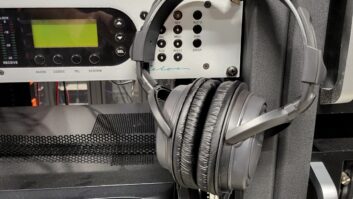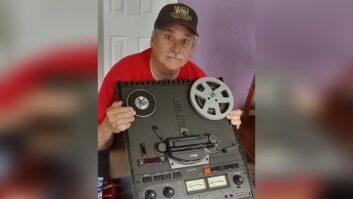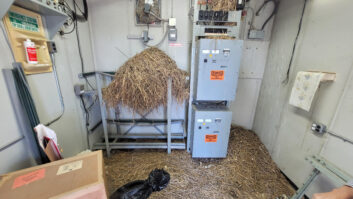I’ll never forget the first time I witnessed an engineer “hot-tune” an AM tuning unit. The OIB dials were set for 50+j0, and the engineer grabbed the coil clip with his bare hand and “tapped” it around the coil ’til the null meter on the bridge read zero. “If you squeeze the clip real hard, you won’t notice the RF!”
I did notice that little blue flame, and that unmistakable zzzzap as the clip came in contact with each coil winding. Where was OSHA in 1970! Ha!
As for me, I chickened out, preferring to use the rubber insulated glove – and with the transmitter at low power. Of course, this was years before anyone considered RFR exposure; it was the burns we were protecting our fingers from, not RF exposure.
How times have changed. One wouldn’t dare match a network in this manner today; or if they did, they wouldn’t tell anyone about the technique, even if they used a rubber glove! There are rare instances, however, when a qualified engineer must work with hazardous voltages, and not just any rubber glove will do.
Charles Fitch, P.E., brought up the importance of selecting gloves as he answered an inquiry from an engineer from the United Arab Emirates. The engineer was asking about glove specifications for electric and telecommunications use. I’d like to share a portion of his reply, and especially the source for standard compliant electrical maintenance gloves – should you need them.
Electrical industry gloves are manufactured to the ASTM D 120 standard. The ASTM is the American Society of Testing and Materials. One of its stated goals is to assure uniformity between similar products of different manufacturers. The stated standard has at least five levels of performance ratings, with maximum work voltage making up one aspect of the ratings.
The standards also ensure that the glove length is sufficient to prevent arcing up the arm, protecting workers handling electric power equipment. Another more desirable feature is the color-coding of gloves, whereby the colors conform to different voltage ratings. This coding is extended to the base tone of the multiple levels used in each layer of the glove. Color layering permits visual detection of any cut or abrasion that may reduce the glove’s effectiveness.
A separate standard outlines glove testing. The testing consists of water poured into the glove to see if any leaks out in a break or cut, and pressure testing with air to spot any imperfections.
Although a number of manufacturers make standard compliant electrical maintenance gloves, Charles has selected gloves from North Safety Products. You can find them at www.northsafety.com/gloves.htm
Note that I mention “qualified” engineer working on this kind of equipment. No radio station is worth dying for – a message of which many of us need a constant reminder. I’m ever amazed at the engineer who will climb towers, just to save his owner a buck. Don’t get sucked into that kind of “dedication.” You may be rewarded with an injury, or worse. If you are not 100-percent sure of the procedure you are about to begin, leave it for the professionals – learn by watching, not by becoming a statistic!
. . .
(click thumbnail)Figure 1: This transmission line was not supported properly. The crinkle is the result.
Site inspections can disclose all kinds of irregularities.
Figure 1 shows a crinkle in a piece of 3-inch flex line that was not properly supported. This cable actually touched the ground before looping back up into the transmitter building.
(click thumbnail)Figure 2 A temporary fix: stainless steel wraplock and sections of garden hose support the line.
Closer inspection disclosed the outer jacket worn away where the cable lay on the crushed stone and was moved by the wind. Lacking the appropriate hangers is no excuse, as good old American ingenuity will prove.
A customer was installing line for a new station, the CP for which expired the next day. The tower crew was short 25 hangers for 3-inch cable. The factory was back-ordered on hangers for a month. The tower crew tried another manufacturer’s 4-inch hangers, but they were too large.
Harris Systems Engineer Paul Barzizza shared a winning idea that provided the temporary support that was needed until the correct hangers could be installed. Shown in Figure 2, stainless steel wraplock and short sections of garden hose were combined to support the line. The 25 missing hangers were spaced throughout the coax run, so the line was supported mostly by the proper hangers. The wraplock hangers filled in the gaps.
Although not a permanent fix, the solution got the station on the air.


. . .
Glen Kippel of KHCS(FM) in Palm Desert, Calif., replied to our reminder to check security lighting at a transmitter site.
Glen went a step further – he has sampled the voltage of the motion-sensing lighting and connected it to a status input on the remote control. The engineer should inform the studio operator of any late-night visit to the transmitter, so the operator doesn’t get “alarmed” (pun intended).
Otherwise, the status light will serve to alert personnel to a potential intruder. A magnetic reed switch installed on the door, and tied to another status channel completes the installation – your own “in house” security system!
. . .
(click thumbnail)Figure 3: Have you checked this lately?
Speaking of in-house systems, how’s your first-aid kit? Do you have stocked kits at both your studio and transmitter sites?
It’s not unusual to find depleted first-aid kits. Open your box and take stock of the supplies.
At the transmitter site, don’t forget to include several bottles of clean water. Figure 3 shows a stocked first-aid kit.

. . .
If you are looking for a good spring-cleaning project, consider replacing the grass and weeds that surround your transmitter building with a carpet of crushed stone.
Ken Sleeman, CE for WWZZ(FM) in Waldorf, Md., placed landscape fabric (which blocks weeds) and a bed of crushed stone in a 4-foot perimeter around the transmitter building. His efforts have been rewarded with a dramatic decrease in bugs, pollen and dust inside the building.
Not only does the site look better, the side benefit of a cleaner transmitter building can’t be ignored.
No budget available? Keep in mind that many garden and landscape centers will gladly trade this kind of service, given the popularity of gardening in the spring and their desire to get “free” advertising on your station.
Submissions for this column are encouraged, and qualify for SBE recertification credit. Fax your submission to (703) 323-8044, or send e-mail to [email protected]












